A cry from the wilds of Mannar
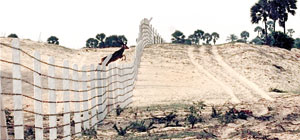
Born free but not allowed to live free: A spotted deer leaps from one side of what used to be its home to the other side. Pic by Dr. Sampath Seneviratne
Unique Mannar Island!
Tread very carefully when leaving a development footprint on this island, for it could do more irreparable and irrevocable harm than good, urge environmentalists.
While in some parts of Mannar Island which covers about 195sqkm any development or human intrusion could crush hundreds of bird-eggs scattered on the ground, in other parts it could be a danger to the mammals, such as spotted deer, feral horses and donkeys which roam the area.
The stark image on the need to free Mannar Island from human encroachment is a beautiful spotted deer, taking a leap from one side of what used to be its home to the other side. Now, its wilderness is under threat, divided by a five-foot high barbed-wire fence. What awaits the deer on the other side is not freedom but more danger in the shape of nasty nooses and cruel traps put in place by man.
The onslaughts on Mannar Island are coming in different forms such as deforestation, illegal encroachments, land-grabs and constructions with allegations that massive projects such as the installation of wind turbines would also toll the death knell for this biodiversity-rich beauty-spot, environmentalists lament.
It is a very emotional environmental activist, Dr. Sampath Seneviratne, Research Scientist on Molecular Ecology & Evolution and Senior Lecturer in Zoology, Colombo University, who has trudged every inch of the island and knows it like the back of his hand, who pleads for intervention both by the authorities and the public.
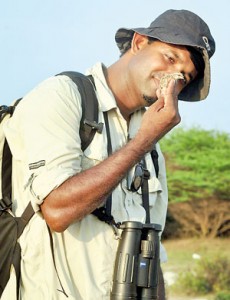
Dr. Sampath Seneviratne: On a mission to save the animals that roam Mannar
“Their (the deer and all creatures on Mannar Island) land has been robbed from them. They desperately need help…. help from all nature lovers. The last of this sensitive and unique habitat (the sand dunes of Mannar Island) is fenced – ready to be destroyed forever. Is there a way to safeguard the remaining few patches of it and all its beauty,” he asks, blaming humanity’s greed, insensitivity and injustice towards these creatures.
“The effects of such unplanned activities will be extremely harmful for the long-term survival of Mannar Island,” reiterates Dr. Seneviratne.
Numerous appeals to the District Secretariat officials seem to have fallen on deaf ears, even though the Central Environmental Authority (CEA) has been quick to respond to urgent pleas whenever specific instances of destruction have been pointed out to them, it is learnt.
Dr. Seneviratne highlights each and every aspect of what is unique about Mannar Island. According to him it has four exclusive eco-systems, not found anywhere else in the country.
Vankalai mudflats – In ultra-low tide, they take on a desert-look, metamorphosing into a lagoon at ultra-high tide. Around 100 species of birds with different beak types access different layers of the water and silt-like mud which is replete with invertebrates such as molluscs and annelids while the ‘forest’ under the mud harbours tasty morsels such as crabs and lobsters for other birds. This unique system supports millions of birds, both migratory and resident, which feed and breed in this undisturbed habitat.
Adam’s Bridge sand dunes and sandy islands – This habitat across 13km with no trees except for a few shrubs provides the ideal environment for animals which hop or fly. The hopping creatures cross when the sand-bars show up during ultra-low tide. This area also serves as a mixing and transferring bowl for Sri Lankan and Indian genes among fauna and flora. With land predators such as dogs, cats, mongooses or snakes unable to cross the waters to the 3rd and 4th islands forming Adams’s Bridge, 11 endangered species of birds lay their eggs, sans nests or any kind of protection, on the bare earth here.
n Sand dunes on the main Mannar Island – These are some of the most well preserved natural sand dunes in the whole of Sri Lanka, where the spotted deer roam, the jungle and fishing cats slink about, wild pigs snort around, the Dry Zone slender loris can be sighted, while a large number of birds can also be seen. This unique desert system bearing similarities to north Sri Lanka and southern India, is used as ‘a staging and re-fuelling area’ by the smaller migrant birds flying from the Himalayan foothills.
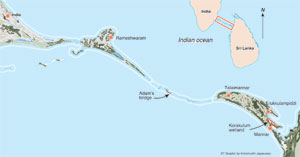
Korakulum wetland – This wetland with fresh water on Mannar Island attracts not only fishing cats, feral horses and donkeys, but also numerous bird species, including the breathtaking flocks of Flamingos.
Pointing out that the whole of Mannar Island has a “huge” significance in the global migratory pathways of a large number of birds, Dr. Seneviratne singles out Korakulum to push home the message for the need to protect and safeguard the area. He describes how Korakulum reflects the rainy and dry seasons, with the wetland water body being ringed by scrub forest. At the height of the dry season, the area becomes a grass-land.
“The mudflats within this wetland are an excellent feeding ground for shorebirds and other aquatic birds during the winter months. When the mudflats dry up during the summer months, they turn into breeding grounds for eight species of birds, two of which are listed as ‘threatened’ species in Sri Lanka’s National Red List,” he says. “It is one of the major wetlands in the Mannar area – the only freshwater lake available for both migratory and resident birds.”
Picturesque are the images, this bird specialist creates in the mind’s eye, substantiated by stunning photographs, for he himself has seen 62 species of land birds, 13 species of seabirds, 26 species of shorebirds and seven species of diurnal raptors from October to April during his walkabouts on the island.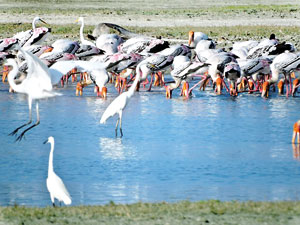
It is also an important breeding ground for resident birds such as the ‘critically endangered’ Spot-billed Duck (Anas poecilorhyncha); ‘endangered’ Large-crested Tern (Sterna bergii), Roseate Tern (Sterna dougallii), Common Tern (Sterna hirundo and Long-tailed Strike (Lanius schach); and ‘vulnerable’ species such as Kentish Plover (Charadrius alexandrines) and Little Tern (Sterna albifrons), the Sunday Times learns.
Korakulam is also a critical feeding ground for more than 10,000 migratory birds including gulls, ducks, storks and shorebirds, says Dr. Seneviratne, adding that the ‘globally vulnerable’ Great Knot (Calidris tenuirostris) uses this wetland annually. Several locally important species such as the Greater Flamingo (Phoenicopterus roseus), the Great Black-headed Gull (Ichthyaetus ichthyaetus), Heuglin’s Gull (Larus heuglini), Eurasian Spoonbill (Platalea leucorodia) and Northern Teal (Anus crecca) are also frequently spotted here.
Not only is it a paradise for birds, according to this naturalist, for the feral horse (Equus ferus) and donkey (Equus africanus) graze in this wetland, while the Jungle Cat (Felis chaus) and Wild Boar (Sus scrofa) as well as endangered butterflies such as the Large Salmon Arab (Colotis fausta), Crimson Tip (Colotis danae) and Joker (Byblia ilithyia) are also found here.
It is in utter despair that he speaks of the mounting threats which include illegal encroachment with land-grabs and scrub-forest clearance being carried out with impunity. Giving specific examples, he says that the land around the lake has been partitioned into a large number of 10-perch lots as well as big lots of about an acre or more by fence posts and barbed-wire fencing. Some of these fences cut right across the wetland.
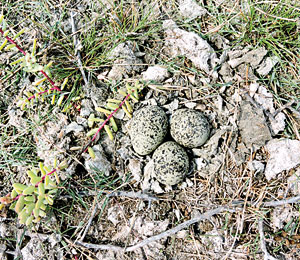
The scrub forest has also been cleared, laments Dr. Seneviratne, pointing out that even the historic Baobab trees have been uprooted and burnt in adjacent areas. Aggravating the situation, two gravel roads have been constructed as access roads to some of these cleared lands.
Garbage and refuse are being dumped on the northeastern boundary of the wetland near the dam, with the high winds littering the wetland with muck.
Meanwhile, the illegal trapping and shooting of waterfowl in Korakulam goes unabated and from the descriptions Dr. Seneviratne has garnered from the culprits he identifies the victims as migratory species such as Pintail and Gargany Ducks, and large gulls such as Great Black-headed and Huglin’s Gulls and also Grey Partridge, with sadly even the endangered Spot-billed Duck may be going into the cooking pot.
The need to conserve mannar island is apparent. It should be done not tomorrow or the next day but right now.ewha
| No issue, says District Secretary There are no major issues in the whole of the Mannar district including Mannar Island now that the clearing of forests has been prohibited nation-wide, said District Secretary M.Y.S. Deshapriya when contacted by the Sunday Times. He said that a problem specific to the Mannar Island was sand mining but that has been curbed as well. Many attempts, meanwhile, to contact the Mannar Divisional Forest Office and the Northern Province office of the Central Environmental Authority were futile. |


